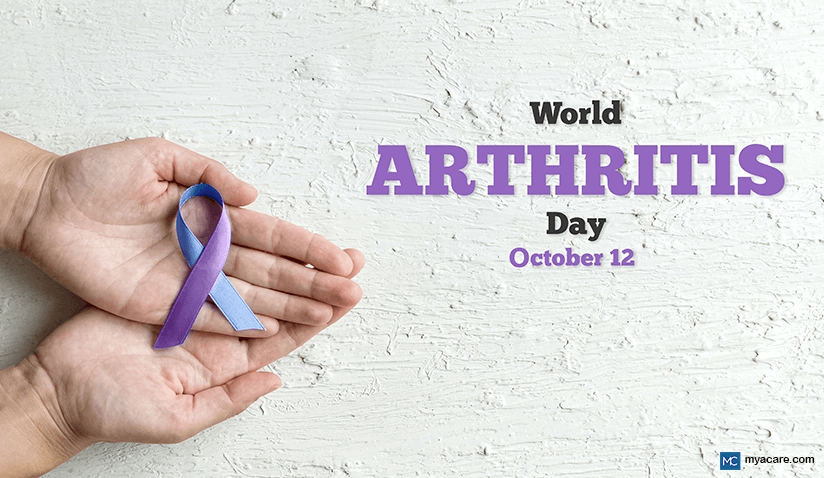Learn About Osteoarthritis This World Arthritis Day

Medically Reviewed by Dr. Rae Osborn, Ph.D. - September 13, 2024
Updated 12 October 2023
World Arthritis Day is a global public health awareness event held every year on October 12 to raise awareness about musculoskeletal and rheumatic diseases, their impact on people's lives, and to educate people about the symptoms and preventive measures, as well as to guide for early diagnosis to avoid further complications. The day focuses on bringing individuals worldwide together on a single platform to promote awareness and provide more opportunities to support and provide better treatment options for people suffering from rheumatic and musculoskeletal disorders.
Osteoarthritis (OA) is the most common type of arthritis. Some call it "wear and tear" arthritis or degenerative joint disease. It is most common in the knees, hips, and hands. The joint cartilage begins to deteriorate with OA, changing the underlying bone.
So, on this special day that brings people of all ages, races, and genders together to increase arthritis awareness, let us learn more about osteoarthritis and recognize the early warning symptoms of the condition.
Understanding Osteoarthritis
Millions of individuals worldwide suffer from osteoarthritis. This develops as the protective cartilage that cushions the ends of the bones deteriorates with time.
OA was once considered a "wear and tear" syndrome related to aging. However, we now understand it is a disease of the entire joint, including cartilage, ligaments, bone, fat, and the tissues that line the joint (the synovium). Osteoarthritis can cause cartilage degeneration, bone form changes, and inflammation, leading to pain, stiffness, and loss of motion.
Causes
Osteoarthritis develops due to the deterioration of the cushioning cartilage at the end of bones. Cartilage is a tough, slippery tissue that allows for frictionless joint mobility. If the cartilage is entirely lost, the bone will scrape against another bone.
The following factors may lead to the development of OA:
- Age: The probability of acquiring OA increases with age, and symptoms often present in adults over 50, but not always.
- Gender: It is unknown why women are more prone than males to develop osteoarthritis.
- Overuse: Overusing the same joints at work or in sports can lead to OA. If your profession or sporting activity causes repetitive stress on a joint, it may eventually lead to the development of OA on that joint.
- Joint injury: Injuries such as those sustained due to accidents or sports participation, can increase the risk of osteoarthritis. Even healed injuries can increase your chances of developing osteoarthritis. A bone fracture, cartilage, or ligament tear can all cause OA, often more quickly than if there is no visible damage.
- Muscle weakness: Poor alignment can arise if muscles do not offer appropriate joint support, which can contribute to OA.
- Abnormalities of the musculoskeletal system: Misalignment of bone or joint structures might hasten the progression of OA. Some people are born with faulty joints or cartilage.
- Obesity: Extra body weight contributes to osteoarthritis in various ways, with the risk increasing with your body weight. Gaining weight increases the strain on weight-bearing joints like your hips and knees. Furthermore, adipose tissue generates proteins that can cause severe inflammation in and around your joints.
- Environmental Aspects: Modifiable environmental risk factors include occupation, degree of physical activity, quadriceps strength, prior joint injury, diet, obesity, sex hormones, and bone density.
- Genetics: Some people are predisposed to osteoarthritis. People who have OA in their families are more prone to develop it.
Symptoms
Osteoarthritis symptoms frequently appear slowly and worsen with time. Osteoarthritis signs and symptoms include:
- Pain: You may experience pain during movement of the affected joints.
- Stiffness: Joint stiffness may be particularly obvious upon waking up or after inactivity.
- Loss of flexibility: You cannot move your joint through its entire range of motion.
- Tenderness: Your joint could feel tender when you lightly press on it or the area around it.
- Bone spurs: Extra bone, which feels like hard lumps, can grow around the affected joint.
- Swelling: Soft tissue irritation around the joint could be to blame.
Different parts of the body may be affected differently by OA, such as:
- Hips: Knee or thigh pain as well as discomfort in the buttocks or groin area.
- Knees: There is a "grating" or "scraping" sensation when moving the knee.
- Fingers: Spurs near the edges of joints can cause swollen, sensitive, and red fingers, sometimes with pain at the base of the thumb.
- Feet: Pain and soreness in the big toe, with ankle or toe swelling, are possible.
Diagnosing Osteoarthritis
Medical history, physical examination, and lab tests all contribute to the diagnosis of OA. Your primary care physician may be the first person you consult regarding joint pain. The physician will examine your medical background, signs and symptoms, how the pain affects your daily activities, health issues, and prescription drug use. In addition, they will examine and move your joints and may order imaging. These tests aid in the diagnosis:
Laboratory tests
Analysis of blood or joint fluid can assist in confirming the diagnosis.
- Blood tests: Although no blood test can currently diagnose osteoarthritis, particular tests can help rule out other causes of joint discomfort, such as rheumatoid arthritis.
- Analysis of joint fluids: A needle may be used by your doctor to remove fluid from an affected joint. The fluid is then checked for indications of inflammation in order to determine whether your discomfort is due to osteoarthritis rather than gout or an infection.
Imaging studies
Your doctor may refer you for imaging of the affected joint.
- X-rays: Cartilage is not seen on X-rays, but narrowing of the area between the bones in your joint reveals the loss of the structure. An X-ray might also reveal bone spurs around a joint.
- Magnetic resonance imaging (MRI): By utilizing radio waves and a strong magnetic field, MRI creates precise images of cartilage, bone, and soft tissue. An MRI is not usually required to diagnose osteoarthritis. However, it can provide additional information in complex cases.
Treatment Options
Although osteoarthritis cannot be reversed, therapies can alleviate pain and improve mobility.
Medications
Among the medications that can help treat osteoarthritis symptoms, particularly pain, are:
- NSAIDs (Nonsteroidal anti-inflammatory drugs). Pain is often relieved with over-the-counter nonsteroidal anti-inflammatory medicines (NSAIDs) such as ibuprofen (Motrin IB, Advil, and others) and naproxen sodium (Aleve), as well as stronger NSAIDs.
- Acetaminophen: Acetaminophen (Tylenol, among others) has been demonstrated to help some people with mild to moderate osteoarthritis pain.
- Antidepressants: Typically used to treat depression, they can be licensed to treat chronic pain, including osteoarthritis.
Therapy
- Physical therapy: A physical therapist can help with exercises that improve the strength of the muscles around your joints, increase flexibility, and reduce pain.
- Transcutaneous electrical nerve stimulation (TENS): This uses a low-voltage electrical current for pain relief.
- Occupational therapy. An occupational therapist can assist you with ways to perform daily tasks without putting further strain on an already hurting joint.
Surgical and other procedures
If conservative therapies are ineffective, in consultation with your Doctor, you may want to explore procedures such as:
- Injections of lubricant: Hyaluronic acid injections may reduce discomfort by cushioning your knee, but some evidence indicates that they may be no more effective at doing so than a placebo. Hyaluronic acid is similar to a substance found in joint fluid.
- Cortisol injections: Corticosteroid injections into your joint may reduce discomfort for a few weeks. Your doctor numbs the region around your joint before inserting a needle into the joint space and injecting medicines.
- Bone realignment: An osteotomy might help if osteoarthritis has worsened the condition of one side of your knee compared to the other. A surgeon performs a knee osteotomy by cutting through the bone above or below the knee. They then remove or add a wedge of bone.
- Replacement of a joint: During joint replacement surgery, your surgeon will replace your damaged joint surfaces with plastic and metal pieces. Infections and blood clots are two potential surgical risks. Artificial joints can become loose or wear out over time, necessitating replacement.
Outlook
Osteoarthritis is a progressive disease. If left untreated, it will worsen over time. Although OA is an uncommon cause of death, it is a substantial source of disability in adulthood.
Consult your doctor if your quality of life suffers from OA. Surgery to replace joints, pain medication, and lifestyle adjustments may be options. Your mobility and general quality of life will increase if your OA symptoms are reduced, regardless of the treatment you select.
Conclusion
Osteoarthritis, the most common form of arthritis, is a severe and painful disorder affecting any joint. Chronic OA pain can progress to complications without treatment and harm your quality of life. Although there is no known treatment for OA, there are strategies to manage it so you may be active, have a good quality of life, and be mobile.
To search for the best Orthopedics Doctors and Healthcare Providers worldwide, please use the Mya Care search engine.
To search for the best doctors and healthcare providers worldwide, please use the Mya Care search engine.
The Mya Care Editorial Team comprises medical doctors and qualified professionals with a background in healthcare, dedicated to delivering trustworthy, evidence-based health content.
Our team draws on authoritative sources, including systematic reviews published in top-tier medical journals, the latest academic and professional books by renowned experts, and official guidelines from authoritative global health organizations. This rigorous process ensures every article reflects current medical standards and is regularly updated to include the latest healthcare insights.

Dr. Rae Osborn has a Ph.D. in Biology from the University of Texas at Arlington. She was a tenured Associate Professor of Biology at Northwestern State University, where she taught many courses to Pre-nursing and Pre-medical students. She has written extensively on medical conditions and healthy lifestyle topics, including nutrition. She is from South Africa but lived and taught in the United States for 18 years.
References:
Featured Blogs



